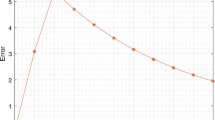Abstract
In this paper, A fuzzy Sylvester matrix equation with crisp coefficient matrices is considered. We use the arithmetic operation rule of fuzzy number to transfer the equation into two crisp Sylvester matrix equations, which avoids using Kronecker operation and which makes it possible to apply some existing methods to solve Sylvester matrix equation. Since the two transferred equations keep the number of unknowns unchanged, numerical operations needed in our method are much less than the operations in the method using Kronecker product. At last, we use several small-scale examples to illustrate the correctness of our method and several large-scale examples to illustrate the efficiency of our method.
Similar content being viewed by others
References
Antoulas AC (2005) Approximation of large-scale dynamical systems. SIAM, Philadelphia
Bartels RH, Stewart GW (1972) Algorithm432:solution of the matrix equation ax + xb = c. Commun ACM 15:820–826
Bouhamidi A, Jbilou K (2007) Sylvestertikhonov-regularization methods in image restoration. J Comput Appl Math 206:86–98
Breiten T, Simoncini V, Stoll M (2016) Fast iterative solvers for fractional differential equations. Electron Trans Numer Anal 45:107–132
Dookhitram K, Lollchund R, Tripathi RK, Bhuruth M (1986) Fully fuzzy sylvester matrix equation. J Intell Fuzzy Syst 28:2199–2211
Dubois D, Prade H (1980) Fuzzy sets and systems: theory and applications. Academic Press, London
Friedman M, Ming M, Kandel A (1998) Fuzzy linear systems. Fuzzy Sets Syst 96:201–209
Goetschel R, Voxman V (1986) Elementary fuzzy calculus. Fuzzy Sets Syst 18:31–43
Golub GH, Nash S, Loan CF (1979) A Hessenberg-Schur method for the problem \(AX + XB = C\). IEEE Trans Autom Contr AC-24(6):909–913
Guo X (2011) Approximate solution of fuzzy sylvester matrix equations. In: Seventh international conference on computational intelligence and security, pp 52–56
Hammarling SJ (1982) Numerical solution of the stable non-negative definite lyapunov equation. IMA J Numer Anal 2:303–323
Hyland C, Bernstein D (1984) The optimal projection equations for fixed-order dynamic compensation. IEEE Trans Automat Control 29:1034–1037
Kressner D (2008) Block variants of Hammarling’s method for solving Lyapunov equations. ACM Trans Math Softw 34(1):1–15
Lancaster P, Tismenetsky M (1985) The theory of matrices. Academic Press, London
Lu A, Wachspress E (1991) Solution of lyapunov equations by alternating direction implicit iteration. Comput Math Appl 21:43–58
Minc H (1988) Nonnegative matrices. Wiley, New York
Raich VV, Tripathi RK, Bawa NPS, Dookhitram K, Dayal SK (2011) Application of interval valued fuzzy matrices in medical diagnosis via a new approach. In: International conference on multimedia technology. IEEE Catalog No. CFP1153K-PRT, pp 3440–3443
Saad Y (1990) Numerical solution of large Lyapunov equation, vol 3. In: Signal processing, scattering, operator theory, and numerical methods, proceedings of the interntational symposium MTNS-89
Salkuyeh DK (2011) On the solution of the fuzzy sylvester matrix equation, soft computing—a fusion of foundations. Methodol Appl 15(5):953–961
Simoncini V (2016) Computational methods for linear matrix equations. SIAM Rev 58(3):377–441
Smith R (1968) Matrix equation xa + bx = c. SIAM J Appl Math 16:198–201
Sorensen DC, Zhou Y (2003) Direct methods for matrix sylvester and lyapunov equations. J Appl Math 6:277–303
Triphathi RK, Raich VV, Dookhitram K, Dayal SK, Sai Hareesh A (2012) Similarity between max min and riv technique with reference to two diseases diarrhea and diabetes. In: National conference on computational intelligence and signal processing, pp 170–174
Wachspress E (1998) Iterative solution of the lyapunov matrix equation. Appl Math Lett 107:87–90
Zimmermann HJ (1985) Fuzzy sets theory and applications. Kluwer, Dorrecht
Acknowledgements
This study was funded by National Natural Science Foundation of China under Grant NSF11271081.
Author information
Authors and Affiliations
Corresponding author
Ethics declarations
Conflict of interest
All authors of this paper have no conflict of interest.
Ethical approval
This article does not contain any studies with human participants or animals performed by any of the authors.
Additional information
Communicated by V. Loia.
Rights and permissions
About this article
Cite this article
He, Q., Hou, L. & Zhou, J. The solution of fuzzy Sylvester matrix equation. Soft Comput 22, 6515–6523 (2018). https://doi.org/10.1007/s00500-017-2702-8
Published:
Issue Date:
DOI: https://doi.org/10.1007/s00500-017-2702-8




